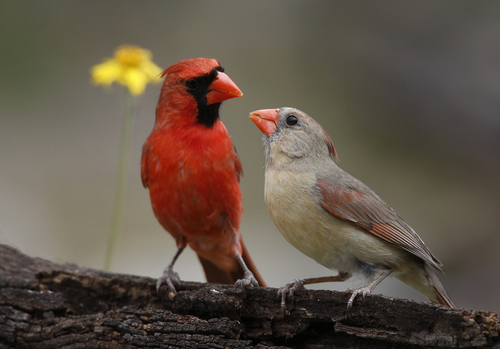
Northern Cardinal
The Northern Cardinal (Cardinalis cardinalis) is a striking, medium-sized songbird native to North America. Renowned for the male's brilliant red plumage, it's a common sight at backyard feeders and a beloved symbol of many regions. Unlike many songbirds, both male and female cardinals sing, offering a variety of clear, whistled songs. Ecologically, they play a role in seed dispersal and insect control. The Northern Cardinal holds cultural significance as the state bird of seven US states, reflecting its widespread presence and popularity.
21-23.5 cm
Length
25-31 cm
Wingspan
Least Concern
Conservation Status
Distribution
Eastern and Central North America, ranging from southeastern Canada through the eastern United States, extending south into Mexico and parts of Central America. Introduced populations exist in Bermuda, Hawaii, and California. They are generally non-migratory, remaining in their territories year-round.
Lifespan
Typically 3-5 years in the wild, although some individuals have been recorded living up to 15 years. Captive birds can live longer.
Northern Cardinal's Habitat
Habitat Types
Woodlands, Gardens, Parks, Shrublands, Thickets
Climate Zones
Temperate, Subtropical
Adaptations
Northern Cardinals are highly adaptable to varied habitats. Their strong, conical beaks are well-suited for cracking seeds, a staple food source, while their generalist diet allows them to thrive in diverse environments. They readily utilize human-altered landscapes, often frequenting bird feeders.
Variations
There are numerous recognized subspecies (around 19), varying slightly in size, bill shape, and plumage color intensity. These variations are often linked to geographic location, with some subspecies exhibiting brighter or duller coloration than others.
Appearance
Breeding Plumage
Males retain their bright red plumage year-round. Females have a buff-brown body with reddish tinges on the wings, tail, and crest. Juveniles resemble females, with young males gradually acquiring their red plumage.
Seasonal Feather Changes
Minimal seasonal variation. Some individuals may exhibit slightly brighter plumage during the breeding season.
Sex Based Plumage Differences
Significant sexual dimorphism. Males are bright red with a black mask around the eyes and bill, while females are primarily buff-brown with reddish accents.
Notable Features
Prominent crest, Black mask (males), Heavy, conical bill, Reddish-orange bill
Diet and Feeding
Primary Foods
Seeds, Fruits, Insects, Berries
Foraging Behavior
Northern Cardinals forage on the ground, in shrubs, and in trees. They often hop along the ground searching for seeds and insects. They will also perch on branches to glean insects or pick berries.
Specializations
Their strong, conical bill is specialized for cracking seeds and crushing hard-shelled insects.
Seasonal Diet Variations
Diet varies seasonally. Insects are more prevalent in the diet during the breeding season, providing protein for growing chicks. Seeds and fruits make up a larger proportion of the diet during the fall and winter.
Behavior
Social Structure
Northern Cardinals are generally territorial, especially during the breeding season. They may form small flocks during the winter, often gathering around food sources.
Communication
Variety of clear, whistled songs, Chip calls used for contact, Males and females both sing, which is unusual for songbirds.
Migration
Non-migratory; they are resident birds that maintain territories year-round.
Territorial or Group Behaviors
Males are highly territorial during the breeding season, defending their territory against other males through song and aggressive displays. Pairs often remain together throughout the year.
Conservation
Threats
Habitat loss (although they adapt well to suburban areas), Collisions with windows, Predation by domestic cats
Protection Programs
General wildlife conservation efforts that protect habitat., Promotion of bird-friendly landscaping practices.
Local National Laws
Protected under the Migratory Bird Treaty Act in the United States, making it illegal to harm or possess them without a permit.
Population Trend
Stable
Population Estimates
Estimated global population of around 100 million individuals.
Interesting Facts
Both male and female Northern Cardinals sing.
This is relatively uncommon among North American songbirds, where males typically do most of the singing.
They are the state bird of seven US states.
This includes Illinois, Indiana, Kentucky, North Carolina, Ohio, Virginia, and West Virginia.
Cardinals sometimes engage in 'anting'.
They rub ants on their feathers, possibly to remove parasites or soothe skin irritation from the formic acid secreted by the ants.
Cardinals can see a wider color spectrum.
Unlike humans, cardinals can see ultraviolet light.
Faqs about Northern Cardinal
What do I do if I find a baby cardinal?
If the bird is feathered and hopping, it's likely a fledgling learning to fly. It's best to leave it alone, as the parents are likely nearby. If it's unfeathered or injured, contact a local wildlife rehabilitator.
Why are cardinals attacking my windows?
They are likely seeing their reflection and perceiving it as a rival. Try breaking up the reflection with window decals, screens, or other deterrents.
What is the best food to attract cardinals?
Black oil sunflower seeds, safflower seeds, and white milo are good choices. They also enjoy suet and crushed peanuts.
How can I tell a male and female cardinal apart?
Males are bright red with a black mask, while females are buff-brown with reddish tinges.
Copyright @ Nature Style Limited. All Rights Reserved.
 English
English